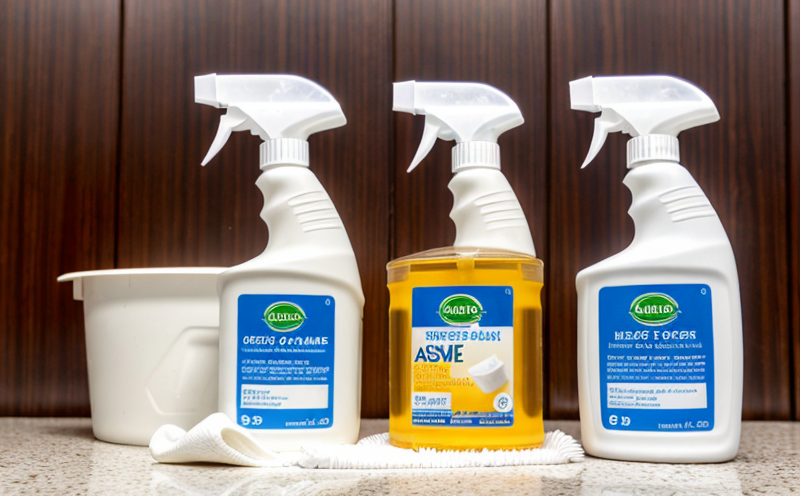DIN EN 1656 Veterinary Disinfectant Testing
The DIN EN 1656 standard is a European norm that provides a comprehensive framework for the testing of veterinary disinfectants. This standard ensures that disinfectants used in agricultural, veterinary, and other relevant sectors are effective against specific pathogenic microorganisms. Understanding this standard’s requirements can help quality managers, compliance officers, R&D engineers, and procurement teams ensure their products meet regulatory standards.
Disinfectants play a critical role in preventing the spread of infectious diseases among animals, ensuring public health, and maintaining hygiene in various environments. DIN EN 1656 covers several aspects including biocidal efficacy, chemical stability, shelf life, and ease of use. This standard is particularly important for products intended to be used on skin, mucous membranes, or inanimate objects.
The testing protocol outlined in DIN EN 1656 involves multiple steps that are designed to simulate real-world conditions where the disinfectant will be used. The tests assess the product's ability to kill pathogens such as bacteria, fungi, and viruses under controlled laboratory conditions. This ensures that the disinfectant is not only effective but also safe for use.
The standard specifies a series of test methods aimed at evaluating different properties of veterinary disinfectants. These include:
- Biocidal efficacy against specified microorganisms
- Residual toxicity assessment on living tissues
- Stability over storage and use conditions
- Potential corrosiveness to materials commonly used in veterinary settings
The testing process involves several key steps:
- Sample Preparation: Samples of the disinfectant are prepared according to specified protocols, ensuring they are representative of the product as it would be used in practice.
- Biocidal Efficacy Tests: The sample is exposed to a standardized inoculum of microorganisms under controlled conditions. After exposure, the remaining viable organisms are counted using appropriate microbiological methods.
- Residual Toxicity Evaluation: The product's residual toxicity on living tissues is assessed by applying it to agar plates containing cells that could be harmed by the disinfectant.
- Stability Testing: Samples are stored under various conditions (temperature, humidity) for periods specified in the standard. Stability tests are conducted periodically throughout storage to ensure the product maintains its efficacy over time.
The results of these tests provide critical information about the disinfectant's effectiveness and safety. Compliance with DIN EN 1656 is crucial for manufacturers who want to ensure their products meet regulatory requirements and can be trusted by end-users in veterinary settings.
Scope and Methodology
| Test Parameter | Description |
|---|---|
| Biocidal Efficacy | Evaluation of the disinfectant's ability to kill a specified set of microorganisms. |
| Residual Toxicity | Determination of whether residual amounts of the disinfectant are harmful to living tissues. |
| Stability Over Time | Evaluation of the product's effectiveness and chemical stability under various storage conditions. |
| Potential Corrosion | Assessment of the disinfectant’s corrosiveness on materials used in veterinary settings. |
The DIN EN 1656 standard covers a range of test methods and procedures designed to ensure that veterinary disinfectants are safe and effective. The biocidal efficacy tests use standardized microorganisms, such as Escherichia coli for bacteria or Candida albicans for fungi, to evaluate the product's performance.
Residual toxicity is assessed by applying the disinfectant to agar plates containing cells of a specific strain. This helps determine if any residual amounts are harmful to living tissues. Stability testing involves storing samples under different conditions (temperature and humidity) over extended periods to monitor changes in efficacy and chemical composition.
The potential for corrosion is evaluated by exposing the product to various materials commonly used in veterinary settings, such as metals or plastics, to assess any corrosive effects. These tests are critical for ensuring that the disinfectant is not only effective but also safe for use in a wide range of environments and applications.
Industry Applications
- Veterinary Hospitals
- Farm Animal Facilities
- Poultry Farms
- Dairy and Livestock Operations
- Zoos and Wildlife Sanctuaries
- Research Laboratories
The DIN EN 1656 standard is widely used in the veterinary disinfectant industry, particularly for products intended to be used on skin, mucous membranes, or inanimate objects. Compliance with this standard ensures that the disinfectants are effective against a broad range of pathogenic microorganisms and safe for use in various environments.
Veterinary hospitals and research facilities rely heavily on disinfectants to prevent the spread of infectious diseases among animals. The standard helps ensure that these products meet the necessary criteria for efficacy, safety, and stability. Farms and livestock operations benefit from DIN EN 1656-compliant disinfectants in maintaining hygiene and preventing outbreaks.
The standard is also critical for zoos and wildlife sanctuaries where strict hygiene protocols are essential to protect both animal health and public safety. Compliance ensures that the disinfectants used meet the highest standards of efficacy, safety, and stability across all applications.
Why Choose This Test
Selecting a testing service for DIN EN 1656 compliance is crucial for ensuring that your veterinary disinfectant products meet the highest standards of effectiveness and safety. By choosing our laboratory, you benefit from:
- Expertise in Regulatory Compliance: Our team of experienced scientists ensures that all tests are conducted in strict accordance with DIN EN 1656.
- State-of-the-Art Facilities: We offer cutting-edge laboratory equipment and facilities to conduct comprehensive testing.
- Comprehensive Test Reports: Our detailed reports provide clear insights into the performance of your products, helping you make informed decisions.
- Fast Turnaround Times: We understand the importance of timely results for product development and market entry. Our efficient processes ensure quick turnaround times without compromising on quality.
By choosing our laboratory, you can trust that your products will meet the rigorous standards set by DIN EN 1656, ensuring they are safe and effective in real-world applications.





